March 14, 2019 feature
Recovering scattered data from twisted light via 'scattering-matrix-assisted retrieval technique (SMART)'
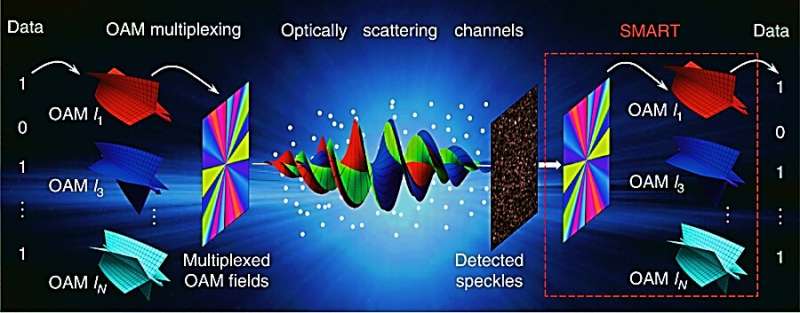
High-capacity optical communication can be accomplished by multiplexing multiple light-carrying orbital angular momentum (OAM) channels. However, in turbulent environments, optical scattering and 'speckle patterns' occur due to ambient, atmospheric microparticles and significantly decrease the orthogonality between OAM channels, demultiplexing (extracting information) and increasing crosstalk during communication. In a recent study now published in Light: Science & Applications, Lei Gong and co-workers at the departments of optics and optical engineering, medical engineering, electrical engineering and physical sciences in China and the USA developed a 'scattering-matrix-assisted retrieval technique' (SMART) to efficiently recover scattered data from multiplexed OAM channels. In the study, they used 24 OAM channels in parallel, passing through a scattering medium to demultiplex the channels from the scattered optical fields and achieve minimal experimental crosstalk approximating -13.8 dB.
The scientists decoded the information of multiple twisting light beams that passed through scattered media containing atmospheric microparticles (causing reduced image quality) and retrieved high quality data from the multiplexed OAM channels instead. The SMART platform allowed high-fidelity transmission of images and reduced the error rate by 21 times compared with previous studies. Gong et al. envision the optimized technique will facilitate high quality optical data transfer in harsh atmospheric conditions or underwater for practical applications.
The scientists implemented the experimental setup in a self-built data transmission system, by employing a digital micromirror device (DMD) to encode OAM channels. They simultaneously provided high-tolerance to misalignment in the setup through reference-free calibration. They then successfully demonstrated the high-fidelity transmission of gray and color images under scattering conditions, at an error rate of <0.08 percent. The technique can pave the way to high performance optical communication in turbulent environments.
Light is a carrier of information during communication and scientists have traditionally aimed to enhance its information-carrying capacity and spectral efficiency by multiplexing the wavelength, polarization and spatial degree of freedom for improved data communication. The OAM of light, recognized by Les Allen in 1992, is considered a promising degree of freedom to multiplex data in free space and optical fibers at the nanoscale. A light beam carrying an OAM is characterized by a helical wave front, is superior to spin angular momentum with two states, and offers unlimited channels for data transmission. As a result of its unique properties, OAM multiplexing is widely applied to achieve high capacity communication in free space and optical fibers.
When light propagates through scattering media or multimode systems, well-known speckle patterns can arise from self-interference of multiply scrambled light. While the speckle patterns differ from the incident light, the encoded information is retained in the speckles and never lost. In fact, speckle patterns depend on the temporal and spatial properties of incident light to extract and use information within the speckles.
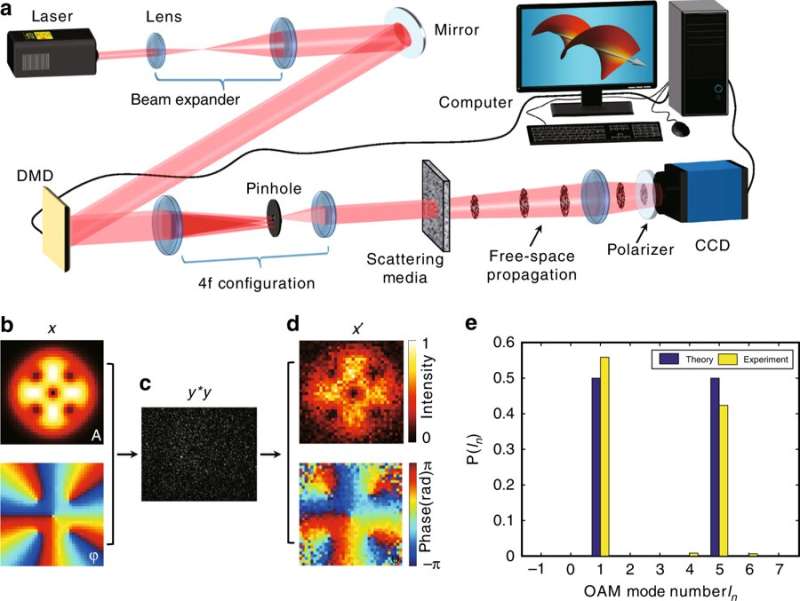
In the present work, Gong et al. proposed the SMART system to precisely extract encoded OAM states from multiply scattered light. The scientists first employed the technique with a speckle-correlation scattering matrix to recover the optical field of a data-carrying vortex beam. The light contained OAM superposition states and the SMART system demultiplexed every OAM channel using the mode decomposition method.
To test the validity of the system, the scientists built an optical wireless data transmission system in a multiple scattering environment. Notably, the SMART system showed good tolerance to system misalignment and permitted non-line-of-sight (NLOS) connection for use in optical communication. After being subject to multiple scattering, the data carrying vortex beam generated a random speckle pattern, which was recorded by a camera and then analyzed using the SMART system.
To experimentally validate the system, Gong et al. constructed an optical data transmission link based on a digital micromirror device (DMD). The setup contained a He-Ne laser as the source of light and a beam expander with a specified magnification, to tune the size of the laser beam. The scientists installed high-speed mode switching in the system to acquire images synchronously, which was also used to execute digitized calculations in the SMART platform.
The scientists used an optical diffuser to mimic an optically scattering environment in the experiment, which they inserted in the path of transmission. Gong et al. then introduced a technique developed via parallel wavefront optimization for rapid reference-free calibration within the same setup.
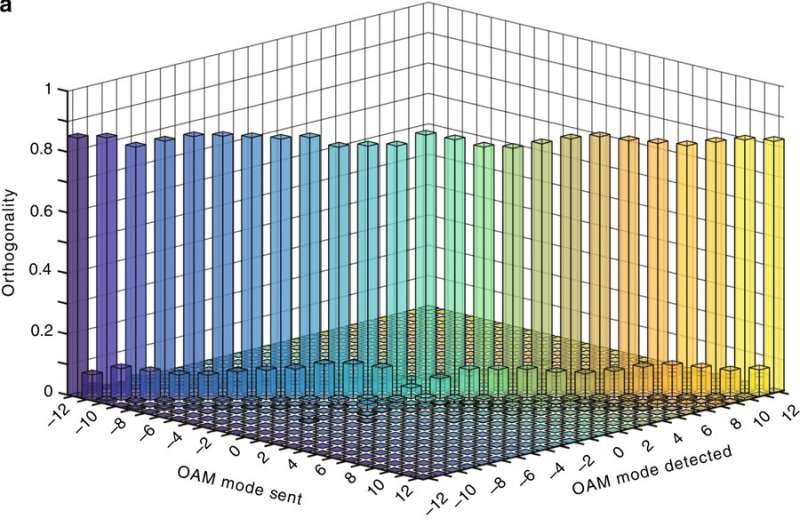
After reducing the potential for crosstalk in the experimental setup, the scientists measured the level of crosstalk at -13.8 dB in the system, acceptable for practical applications. The technique showed good tolerance and immunity to misalignment, indicating that the SMART platform was robust for practical implementation and advantageous for SMART data transfer.
To transfer optical data under scattering, Gong et al. used a digital method and encoded the binary data carried in multiplexed OAM states into a single laser beam. During data transfer, the scientists allowed information encoding by directly generating a light field that represented the OAM superposition state. For example, a grayscale picture with 256 gray levels was represented with a binary digital byte with 8 bits; where every bit took a value from 0-1. To encode the byte, the scientists used an OAM superposition state containing 8 OAM bases, where each correlated with one bit. For instance, the gray level of 111 has the binary byte of '01101111' in the OAM spectrum.
Using simple criteria derived in the study, the scientists showed the OAM spectrum retrieved with the SMART platform was in good agreement with the theoretical result. By following the experimental strategy developed in the work, Gong et al. transferred a gray picture (Rubik's cube) across a scattering medium. Experimentally, the scientists received the transferred picture with an error rate of zero; defined as the ratio of incorrect pixels in the decoded image to all pixels of the image, indicating that all pixels in the image were perfectly transferred. The scientists attributed the high performance to the low error of every OAM channel in the retrieved spectrum.
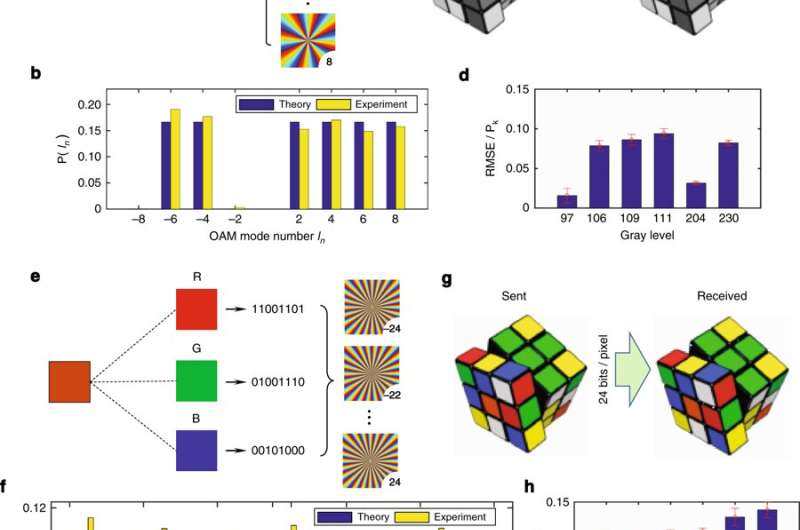
To transfer a color image, Gong et al. employed a superposition state of 24 OAM components to encode the data. The scientists verified the experimental and theoretical transmission of data, while indicating that the platform behaved well for data transmission. Based on these results, the scientists transferred a color image of Rubik's cube with an error rate of 0.08 percent, higher than before but promising lower error in data transmission. In addition to binary digital data transfer, the scientists showed that the SMART platform had great potential for complex spectral analyses and the measurement of phase.
In this way, Gong et al. introduced a SMART platform for data retrieval, which when compared with previous OAM-demultiplexed systems offered two key advantages by:
1. Employing a digital method to identify each OAM channel.
2. Recovering the OAM superposition state from highly scattered speckles and then demultiplexing each OAM channel for data retrieval.
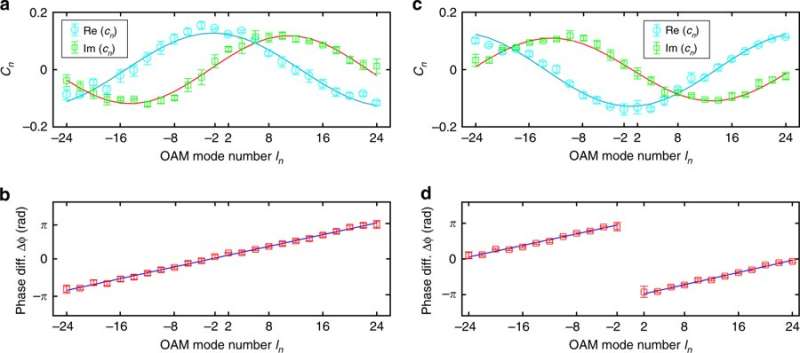
Limits of the method included the necessity for pre-calibration and data processing, which were experimentally time consuming. The OAM-based data transmission operated across a distance of 3 meters in a laboratory environment, the scientists conducted data analysis on a personal computer. For long distance transmission, they propose using a higher power laser, a larger aperture collecting lens and good alignment in the optical system to improve the signal to noise ratio (SNR).
The proposed SMART prototype can be further optimized prior to practical applications. The technique will offer opportunities for high-performance optical wireless communication under scattering conditions, multimode fiber-optic communication and harsh underwater optical communication. The results will also benefit OAM-based quantum communication, high-dimensional quantum key distribution, quantum encryption and quantum memory for efficient data transfer in turbulent environments.
More information: 1. Optical orbital-angular-momentum-multiplexed data transmission under high scattering www.nature.com/articles/s41377-019-0140-3 Lei Gong et al. 06 March 2019, Light: Science & Applications.
2. Parallel wavefront optimization method for focusing light through random scattering media www.osapublishing.org/ol/abstr … .cfm?uri=ol-36-6-870 Meng Cui, 2011, Optics Letters, OSA Publishing.
3. Controlling waves in space and time for imaging and focusing in complex media www.nature.com/articles/nphoton.2012.88 Allard P. Mosk et al. May 2012, Nature Photonics.
Journal information: Light: Science & Applications , Optics Letters , Nature Photonics
© 2019 Science X Network




















